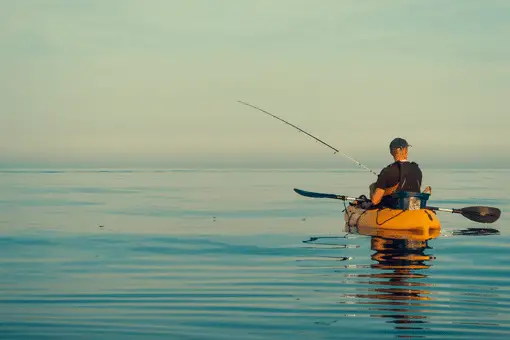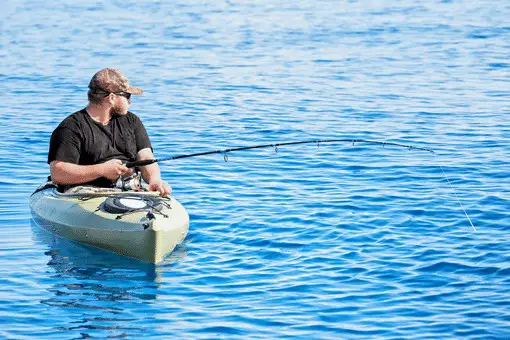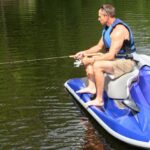Mounting a trolling motor on your kayak can give you an edge over other anglers. It gives you easy access to remote and under-fished waters that would otherwise take so much time and effort to reach by paddling that you would be too tired to fish. But mounting a trolling motor can be a tedious process of trial and error. So, how should you mount a trolling motor to a kayak?

There are few clear-cut rules for how to mount a trolling motor to a kayak because the process depends on the brand of motor and the model of your kayak. You can side-mount or rear-mount most trolling motors. Side-mounting is usually the easiest, but rear-mounting offers more balance and stability.
Trolling motors are sold as a quick and easy fix for propelling small watercraft, but anyone who has tried installing one will know that “quick and easy” is not an accurate description. In this guide, we will look at some things you should know before you mount your trolling motor to your kayak and then examine two efficient ways to do so quickly and relatively painlessly.
Things To Know Before Mounting A Trolling Motor To A Kayak
Being adequately prepared for what’s to come is half the battle, so let’s start by looking at the things you should know and have in place before you even touch your kayak.
There Are Many Right Ways To Mount A Trolling Motor
You will never find a 100% perfect guide for mounting a trolling motor. That’s because there are hundreds of different trolling motor brands and models, not to mention the many different kayak shapes and mounting brackets available. Your best bet would be to use the steps we will be covering here but to take them within the context of the user manual you get with your trolling motor.
Guidance from someone who has done it before is also not a bad idea, especially if you can get an extra pair of helping hands in the process.
In general, take the steps we share here and adapt them according to your trolling motor, bracket, and kayak. It’s almost guaranteed that there will be differences.
You May Have To Buy Some New Tools
Unless you are already actively installing and mounting equipment on various vehicles, you will probably have to buy some tools or add-ons to mount your trolling motor successfully. You may have to drill into your kayak, tighten bolts, and even do some electrical work and waterproofing, and if you don’t have the tools to do so, you will have to get them.
Study Your Kayak First
There are different options for mounting a trolling motor to your kayak. For example, you can choose between rear-mounted or side-mounted options. You have to spend some time in your kayak to see how you usually use it, and this will help you to decide which mounting option would work best for you and give you an idea of where on your kayak you’re willing to lose some space.

Side-Mounting A Trolling Motor To A Kayak
Side-mounting is often the cheapest and easiest way to mount a trolling motor, as it requires the least amount of equipment, and mounting it is a simple, straightforward process. But there are a few pros and cons to side-mounting that you should keep in mind.
Advantages Of Side-Mounting:
- It’s cheap compared to rear-mounting.
- It’s the easiest way to mount a trolling motor.
Disadvantages Of Side-Mounting:
- Your kayak will be slightly off-balance.
- You have to overcompensate, especially during turns.
- You don’t have many controls since it mainly consists of a lever to lower and raise the motor, which you can also use to make it go forward and backward.
How To Side-Mount A Trolling Motor
To side-mount your trolling motor, you need the following:
- The trolling motor with its control lever
- A battery pack and waterproof housing (usually available in one package)
- A side-mounting bracket
Most side-mount systems come with two small brackets you attach to your kayak and an aluminum rod with a flat piece of metal at one end. To mount it, simply follow these steps:
- Measure out where you want the mounting bracket to go. It should be directly behind your seat. Simply place the two small brackets more or less where you want them and place the aluminum rod over them to ensure they are correctly aligned. When satisfied with the alignment, mark the spots on your kayak where you have to attach the brackets.
- Check the size of the bolts or screws that will hold the brackets in place, then drill holes into the sides of your kayak that are just big enough to fit those screws or bolts.
- Place the brackets over the holes you drilled and fasten them properly using the bolts or screws provided.
- Once the brackets are attached, the aluminum rod should easily clip into them. The brackets should also have quick-release buttons to remove the frame again afterward.
- The end of the rod with the flat metal plate should go on the side where you want the trolling motor to be.
- Now attach the trolling motor to the flat metal piece of the rod using the clamps provided.
- Next, you have to fit the battery housing. You can get a separate battery and housing or buy an all-in-one system; it’s up to you. Whichever you choose, you will have to identify a spot where you want to mount it, then mark the places where you will have to fasten it.
Some kayaks come with pre-drilled holes for this purpose, but more often than not, a rope or cable system will be best since that does not require any drilling.
- Connect your trolling motor to the battery. The motor usually has two wires, red and black. The red wire should go to the battery’s positive terminal, and the black wire should connect to the negative.
- Make the electrical parts safe. You don’t want water spraying on connectors, and you don’t want loose wires lying around where things can accidentally get caught in them.
- Take your kayak to the water and test it. Start in reasonably shallow water to ensure everything works before taking it out into the deep water. Don’t test it out of water since prolonged use of the trolling motor outside of water could lead to overheating and damage.
Rear-Mounting A Trolling Motor To A Kayak
Rear-mounting a trolling motor is generally considered the best option, but it also has some advantages and disadvantages.
Advantages Of Rear-Mounting:
- It solves the issue of an off-balance kayak.
- No more overcompensation when you turn.
- Some rear-mount trolling motors have quite sophisticated controller boards.
Disadvantages Of Rear-Mounting:
- It can be more expensive than side-mounting.
- It’s generally more challenging to install.
How To Rear-Mount A Trolling Motor To A Kayak
Rear-mounting has more variables than side-mounting, which is why it’s generally more complex. There’s a good chance your kayak already has a space ready-made for a trolling motor at the rear and perhaps even a water-tight battery box. Most rear-mount trolling motors include brackets; some are even standardized to fit specific kayaks. That would make life much easier.
Then again, it’s also possible that neither your kayak nor the motor has anything pre-fit, in which case you will have to do everything yourself.
So, it’s more important than ever to take these steps as a general guideline rather than explicit instructions. The rear-mounting process generally involves the following steps:
- Identify where the mounting bracket should go. See if there’s a spot that’s already been prepared for a trolling motor at the rear of the kayak, and if there is, check if it aligns with your mounting bracket.
If there isn’t, or the alignment isn’t correct, measure out where you want the mounting bracket to go by placing it more or less where you want it. When satisfied with the alignment, mark the spots on your kayak where you must drill the holes to attach the bracket.
- Check the size of the bolts or screws that will hold the brackets in place, then drill holes into the rear of your kayak big enough to fit those screws or bolts.
- Place the bracket over the holes you drilled and fasten it properly using the bolts or screws provided.
- Now attach the trolling motor to the bracket using screws, bolts, or clamps provided with the bracket and motor. This part is easy if you purchase a complete kit since you won’t have to wonder how to attach it.
- Next, you have to install the battery. This part should be simple if your kayak already has a battery box. If not, you will have to identify a spot where you want to mount the battery box, then mark the places where you will have to fasten it. You can usually attach the battery box with screws, bolts, ropes, or cables.
Bolts are more secure, but not all kayaks have the necessary room to drill holes, in which case ropes or cables will have to do.
- Connect your trolling motor to the battery. The motor usually has two wires, red and black. The red wire should go to the battery’s positive terminal, and the black wire should connect to the negative.
- Make the electrical parts safe. You don’t want water spraying on connectors, and you don’t want loose wires lying around where things can accidentally get caught in them.
- Take your kayak to the water and test it. Start in reasonably shallow water to ensure everything works before taking it out into the deep water. Don’t test the motor without putting it in water first since prolonged use of the trolling motor outside of water could lead to overheating and damage.
Conclusion
It’s not overly complicated to mount a trolling motor to a kayak, but the process will depend on variables like your model of kayak and the brand of trolling motor you buy. Side-mounting is a general low-effort and low-cost option that works well for most people, but if you want better balance and control, rear-mounting is worth the effort and additional cost.
- Do You Need An Indicator For Nymph Fishing? - November 16, 2023
- Fishing Safety Tips For Families - September 25, 2023
- What Is The Best Time To Night Fish At A Lake? - September 18, 2023


![Kayak Fishing for Beginners [10 Tips for a Successful Trip] fishing kayak moored on a beach](https://irvinelake.net/wp-content/uploads/2022/12/kayak-fishing-for-beginners-150x150.png)






